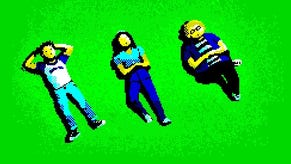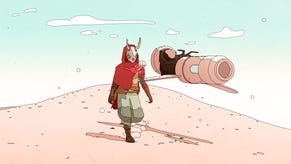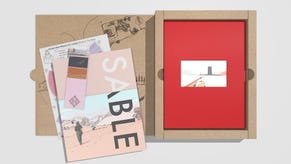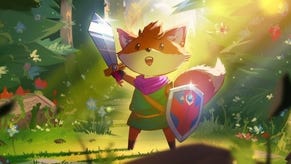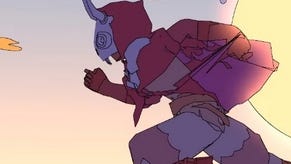Sable review: sparseness and beauty
Zen and the art.
It's funny how much the mind fills in. The art for Sable: you could say, hey, it's Moebius, the French artist who once made the Silver Surfer such an elegant, lonesome presence, a needle of swift, glittering will darting above the blasted canyons of Manhattan. Or you could talk of the thinness of the line, the slow-strobing pastel colours, the sparing use of shadow.
But these are just separate pieces, and the mind fills everything in anyway. It works with the emptiness, giving this desert landscape with its speckled earth and Vegas carpet of exposed strata an overwhelming sense of spent time. Time passing! Centuries have soaked into the ground, bleaching animal bone and dulling machinery, revealing a hard, dry world scoured of obvious context. Wide expanses of sand make you wonder about what forgotten lake once pooled here. Meanwhile, the thin black line that gives the game its illustrative flair works on the scattered dwellings, rendering plasterwork with a powdery, ossuary feel, the ragged scraps of sheeting flapping like old shrouds.
The trees, what trees there are outside of the forest region, can seem seared, the outer bark stripped away by the sun. Elsewhere, the huge things lying about are ancient scrap, half-pipe fragments of something that was once vast and science-fictiony. Smoke rises against thin clouds - a clue? A prompt? And then night falls and the sky is suddenly so dark, so blue, the land loses its banding to the wonderful gloom, and the stars come out and make everything a delight.
Sable is a game set in a science fiction desert, delivered in those French sci-fi lines, both intricate and, paradoxically, sparse and airy. And Sable is a person in the game, the main character, who has reached a point in adolescence which means she must undertake a journey away from her home on her sand bike - a rite of passage that can only lead to adventure.
What I love about Sable - beyond the setting and the aesthetic - is that it is refreshingly easy going about what form that adventure takes. There is a very simple guiding principle here. Who do you want to become? Sable is searching for her place in the world, and so as you play, you earn badges from quest givers for completing various tasks. The badges represent the kind of task undertaken, or the person who set it. Scrap collector? Guard? Something stranger? Get three of a kind and you can trade it in for a mask that stands for that line of work. At the end of the game - you choose this point once you have a few masks in your possession - you pick a mask. This is not a spoiler. The game is quite open about its intent. No combat. No bosses. You find Sable a place in the world.
I have made that sound complicated, but it basically comes down to: do the things you like doing, the things that tug at you. For me, that meant cartography, and cartography in turn meant climbing. Cartographers are scattered around the game's desert, always up high because they must get a view of the landscape. So you see them in the distance and then you have to work out how to get up to them - a climbing puzzle! Sable uses Breath of the Wild's climbing system - a stamina gauge married to the fact that you stick to most surfaces. Up you go, from ledge to ledge as you rest and rebuild your stamina for the next leg.
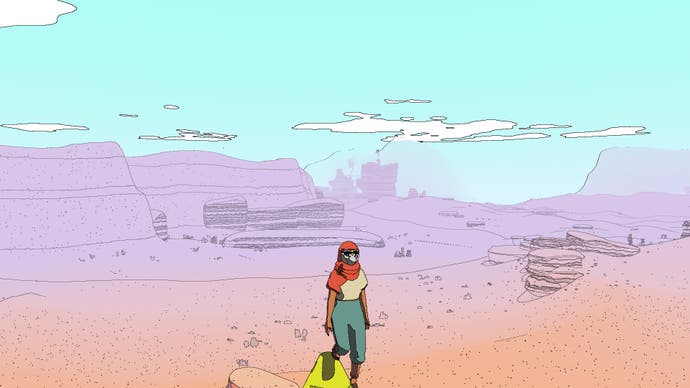


Early on a cartographer will be above a low tower or a simple bluff. My favourite moments in Sable come much later, though, exploring the game's outer reaches. One cartographer was atop a huge architectural piece of scrap - the remains of a crashed and looted ship of some kind. To get there I had to unriddle the correct route, seeing which parts of the landscape would get me a little higher, and then seeing where I could move on from there. It took me about fifteen minutes. And that's nothing compared to the cartographer hidden out in the middle of nowhere, perched on a rocky spire that could only be accessed by arcing bridges made of ancient animal spines, giant things, tinkling like glass underfoot - that sense of balance some old things have, alternating toughness and fragility.
Cartographers sell you a map when you reach them, slowly filling in the game's multi-part world. But they also tell you of areas of interest nearby - areas they will not put on the map for you. And they tell you of other regions of the world that might be close, encouraging you to play a game with the wordless maps and the testimony of the people you meet, who will say, "Oh, the thing you want is south-east of here, in the North Badlands." North Badlands? Spaces and words must be brought together in your head here, like real exploration.
One last thing about cartographers. Some are cheerful. It can be a pleasure to find them up there after a long climb, accompanied by jaunty cartographer music. Some are mild, some shy, some grumpy and almost paranoid. They are all people, all themselves. Everyone in Sable wears a mask - the mask of their calling I guess. But the masks allow the characters to come through more strongly in the writing, which is deft, sparse, that word again, but warm, always hinting at a fully-realised world that comes through in pieces, a glittering mosaic of interactions, gold hidden in a handful of sand.
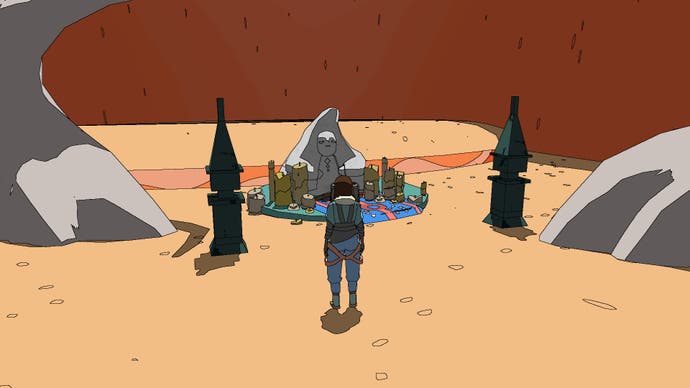
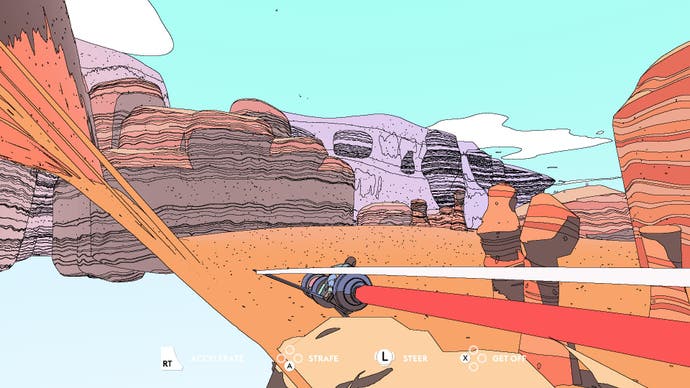
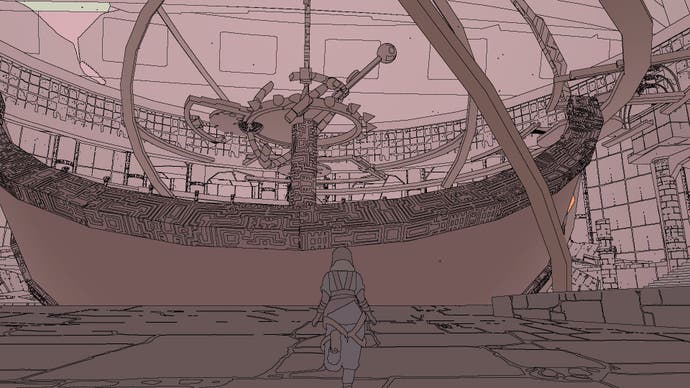
I think I like the cartographers the best not just because of the climbing, or because they allow me to fill in the map, but because you don't need to be told to look for them. You just see them on the horizon and you want to explore. This is something of a tension in Sable, I think: this is what it wants you to do, to go off on your own, the rite-of-passage thing, but it also needs to give you a bit of framework, a bit of a shove, and so there are quests and quest-givers, and can-you-get-me-three-of-these tasks.
They are fine, and they do work towards the objectives of the badges and the masks. But I feel like the game always wants you to step away from them. It allows you to step away, to pick and choose who to ignore, what to abandon. It gives you a sand bike that allows you to cover huge distances. Just point it and putter off trailing smoke or sending out a sweet euclidean beam of laser. And it gives you that map that fills in - fills in to an extent, the open spaces are the real point here - with icons as you find stuff. Quests are nice - go and see why the wind tower has stopped turning, I enjoyed that one. But so much better to just explore, to race across a daringly empty world. To see a new shape appearing in thin lines on the horizon like an image on an etch-a-sketch. To get closer and find a statue, a huge bell-shaped building, a rock formation, a crashed ship. All of these things will have little challenges inside of them, but more than that they speak of scale and age and a certain loneliness. The stuff that makes Sable great.

The challenges are often brilliant though. Get three pieces of beetle dung - fine, I'll do it. But midway through the journey of Sable, I found a huge building in the middle of nowhere and waited for the best part of twenty minutes for the landscape to align with the light in a way that would allow me to spring a trick door open. I can't remember what my reward was - it probably wasn't very much: a new pair of trousers or a jacket. But I remember the puzzle, and the way it was baked into the environment, and the confident way it made me stop and notice things and just wait, for the sun to move, the shadows to align, for Sable to operate as a place as well as a game - a place that is also a game.
Sable is full of this. And such is its commitment to player freedom, I've finished and watched the credits and I still know I've seen only a small fraction of what this world has to offer. Its emptiness somehow contains multitudes. That bike of mine - I can swap out parts and change its colours. Those trousers I found a while back, I can go for the full set. There are spaceships whose lonely AIs tell a story you can stitch together if you can reach them all. There are people to meet and artefacts to ponder.
But to properly experience Sable, all you need is to be between these things - on your bike, lost in the curated emptiness, wondering where to head next. Changing plans, ignoring quests, keeping an eye on the horizon. Not bad, really.




